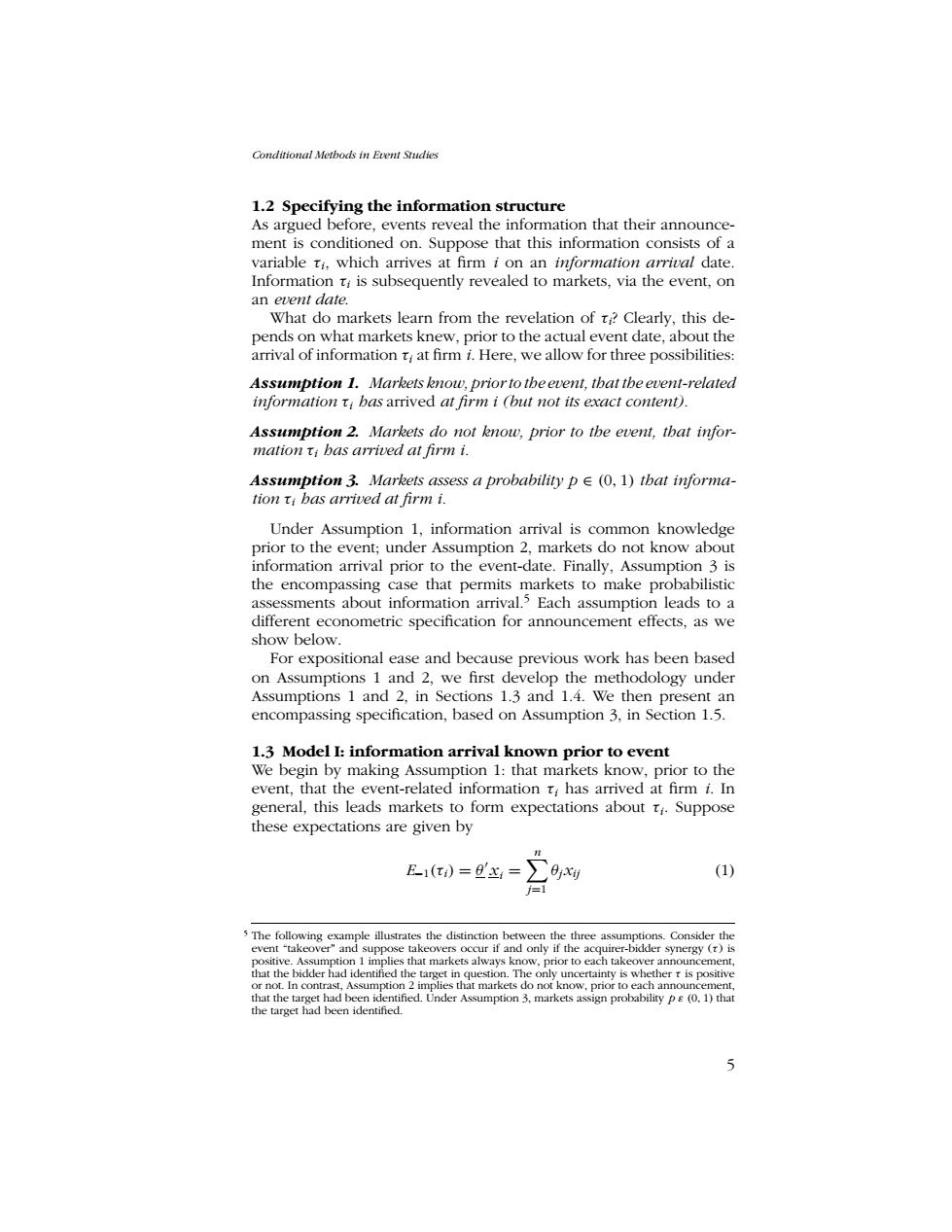正在加载图片...

Conditional Metbods in Event Studies 1.2 Specifying the information structure As argued before,events reveal the information that their announce- ment is conditioned on.Suppose that this information consists of a variable ti,which arrives at firm i on an information arrival date. Information ti is subsequently revealed to markets,via the event,on an event date. What do markets learn from the revelation of t?Clearly,this de- pends on what markets knew,prior to the actual event date,about the arrival of information t;at firm i.Here,we allow for three possibilities: Assumption 1.Markets know,prior to the event,that the event-related information t;bas arrived at firm i (but not its exact content). Assumption 2.Markets do not know,prior to the event,that infor- mation ti bas arrived at firm i. Assumption 3.Markets assess a probability p (0,1)that informa- tion ti bas arrived at firm i. Under Assumption 1,information arrival is common knowledge prior to the event;under Assumption 2,markets do not know about information arrival prior to the event-date.Finally,Assumption 3 is the encompassing case that permits markets to make probabilistic assessments about information arrival.5 Each assumption leads to a different econometric specification for announcement effects,as we show below. For expositional ease and because previous work has been based on Assumptions 1 and 2,we first develop the methodology under Assumptions 1 and 2,in Sections 1.3 and 1.4.We then present an encompassing specification,based on Assumption 3,in Section 1.5. 1.3 Model I:information arrival known prior to event We begin by making Assumption 1:that markets know,prior to the event,that the event-related information t;has arrived at firm i.In general,this leads markets to form expectations about ti.Suppose these expectations are given by E1(t)=Ex1= (1) =1 5 The following example illustrates the distinction between the three assumptions.Consider the event "takeover"and suppose takeovers occur if and only if the acquirer-bidder synergy (T)is positive.Assumption 1 implies that markets always know,prior to each takeover announcement, that the bidder had identified the target in question.The only uncertainty is whether t is positive or not.In contrast,Assumption 2 implies that markets do not know,prior to each announcement, that the target had been identified.Under Assumption 3,markets assign probabiliry ps(0,1)that the target had been identified. 5Conditional Methods in Event Studies 1.2 Specifying the information structure As argued before, events reveal the information that their announcement is conditioned on. Suppose that this information consists of a variable τi, which arrives at firm i on an information arrival date. Information τi is subsequently revealed to markets, via the event, on an event date. What do markets learn from the revelation of τi? Clearly, this depends on what markets knew, prior to the actual event date, about the arrival of information τi at firm i. Here, we allow for three possibilities: Assumption 1. Markets know, prior to the event, that the event-related information τi has arrived at firm i (but not its exact content). Assumption 2. Markets do not know, prior to the event, that information τi has arrived at firm i. Assumption 3. Markets assess a probability p ∈ (0, 1) that information τi has arrived at firm i. Under Assumption 1, information arrival is common knowledge prior to the event; under Assumption 2, markets do not know about information arrival prior to the event-date. Finally, Assumption 3 is the encompassing case that permits markets to make probabilistic assessments about information arrival.5 Each assumption leads to a different econometric specification for announcement effects, as we show below. For expositional ease and because previous work has been based on Assumptions 1 and 2, we first develop the methodology under Assumptions 1 and 2, in Sections 1.3 and 1.4. We then present an encompassing specification, based on Assumption 3, in Section 1.5. 1.3 Model I: information arrival known prior to event We begin by making Assumption 1: that markets know, prior to the event, that the event-related information τi has arrived at firm i. In general, this leads markets to form expectations about τi. Suppose these expectations are given by E−1(τi) = θ0 xi = Xn j=1 θjxij (1) 5 The following example illustrates the distinction between the three assumptions. Consider the event “takeover” and suppose takeovers occur if and only if the acquirer-bidder synergy (τ ) is positive. Assumption 1 implies that markets always know, prior to each takeover announcement, that the bidder had identified the target in question. The only uncertainty is whether τ is positive or not. In contrast, Assumption 2 implies that markets do not know, prior to each announcement, that the target had been identified. Under Assumption 3, markets assign probability p ε (0, 1) that the target had been identified. 5